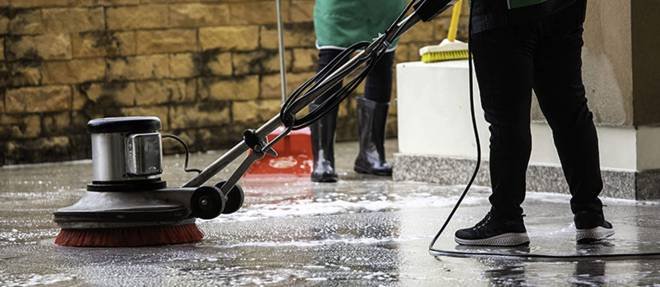
Warehouse cleanliness is a critical component of operational efficiency and safety. Maintaining a clean warehouse promotes a healthy work atmosphere, safeguards priceless goods, and guarantees efficient operations. However, keeping a warehouse clean is a difficult chore. The sheer size, high traffic, and diverse range of activities in a warehouse make cleaning a complex, ongoing process.
In this guide, we will explore the importance of a clean warehouse, the challenges that come with maintaining it, and practical steps to ensure every inch of your facility stays spotless. From creating a cleaning plan to executing specialised tasks, we’ll cover everything you need to know to keep your warehouse in top shape.

The Different Areas of a Warehouse
Warehouses are complex environments with distinct areas that each require tailored cleaning approaches. Understanding these areas is the first step towards effective cleaning.
Storage Areas: These zones house products and materials, often in high quantities. Cleanliness here is crucial for maintaining inventory quality and ensuring that goods are easy to locate and access.
Loading Docks: Serving as the gateway for goods entering and leaving the warehouse, loading docks are high-traffic areas prone to dirt and debris. Cleaning must be done on a regular basis to avoid contamination and mishaps.
Office Spaces: Although they may seem less critical, clean office spaces contribute to a professional atmosphere and support productivity. These areas should be included in the overall cleaning plan.
Breakrooms and restrooms are high-use areas that require frequent sanitation to maintain hygiene and employee morale. Cleanliness in these spaces is also crucial for preventing the spread of germs and ensuring employee well-being
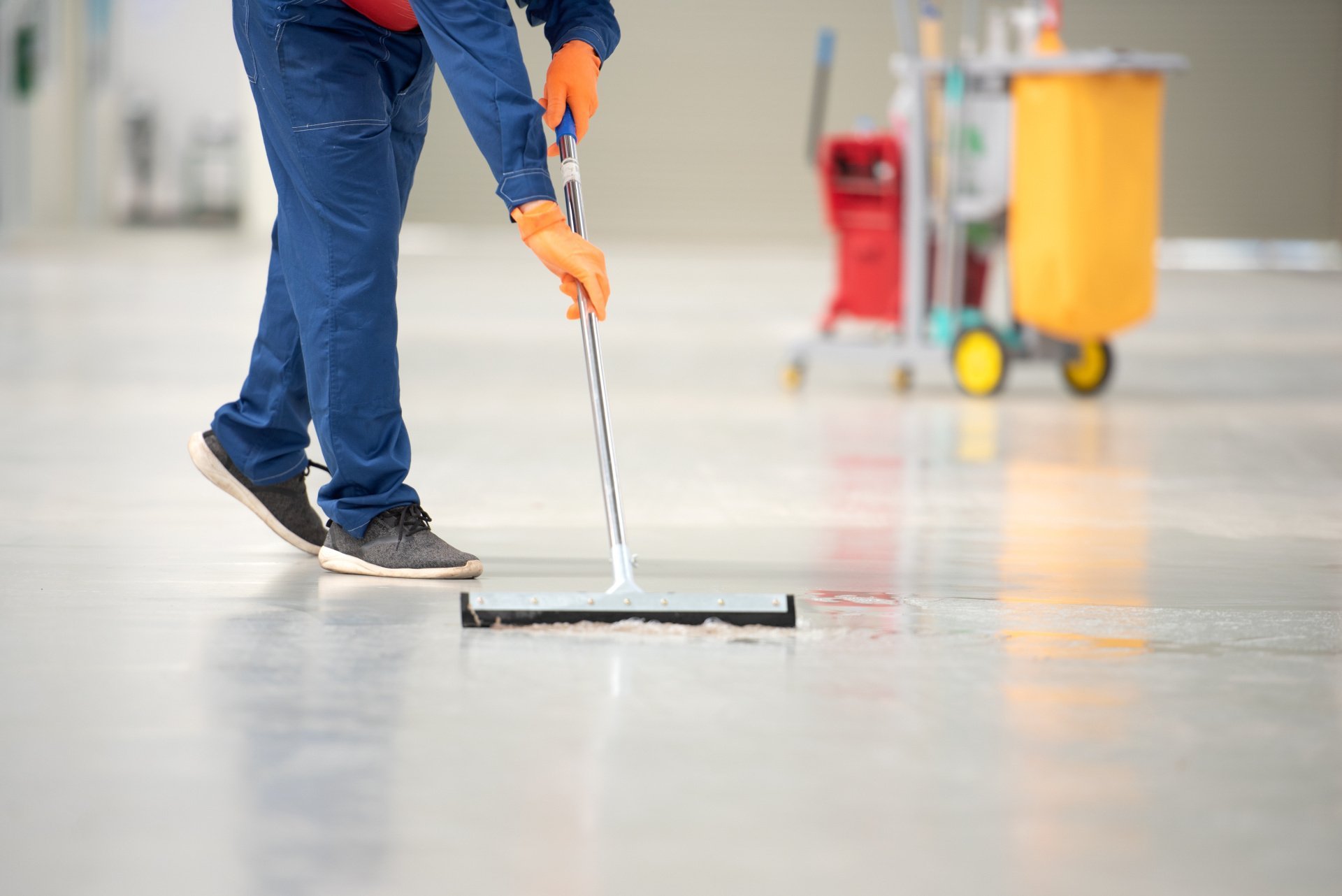
Benefits of a Clean Warehouse
Investing time and resources in warehouse cleanliness yields numerous benefits, including:
Improved Safety: Accidents are less likely in a clean warehouse. Clutter-free aisles and clean floors prevent slips, trips, and falls, while clear pathways minimise the risk of collisions between workers and machinery.
Enhanced Productivity: Workers perform better in a tidy, well-organised workplace. Reduced search times for materials and tools mean faster operations, leading to higher productivity levels.
Better Inventory Management: Clean storage areas prevent damage to goods, reduce the risk of contamination, and help maintain accurate inventory records. Better order fulfilment and customer satisfaction follow from this.
Prolonged Equipment Lifespan: Dust and debris can wreak havoc on warehouse machinery, leading to premature wear and tear. Frequent cleaning lowers maintenance costs and downtime by extending the life of equipment.
Positive Company Image: A clean warehouse sends a strong message to clients, partners, and employees about your company’s commitment to excellence and professionalism. It also fosters a sense of pride among workers, contributing to a positive workplace culture.
Common warehouse cleaning challenges
Cleaning a warehouse presents unique challenges that must be addressed to maintain a pristine environment:
Large Surface Areas: Warehouses often cover vast spaces, making it challenging to clean every corner efficiently. High ceilings, wide aisles, and extensive floor areas require specialised equipment and methods to ensure thorough cleaning.
High Ceilings and Hard-to-Reach Spots: Dust and debris accumulate in places that are difficult to access, such as rafters, ceiling fans, and light fixtures. These areas often require tools or professional services to clean effectively.
Heavy Foot and Equipment Traffic: The constant movement of goods, people, and machinery introduces dirt, oil, and debris into the warehouse. High-traffic areas, in particular, need frequent cleaning to maintain safety and cleanliness.
Varied Types of Debris: Warehouses accumulate a wide range of debris, from packaging materials to liquids. Each type requires different cleaning techniques and tools, adding complexity to the cleaning process.
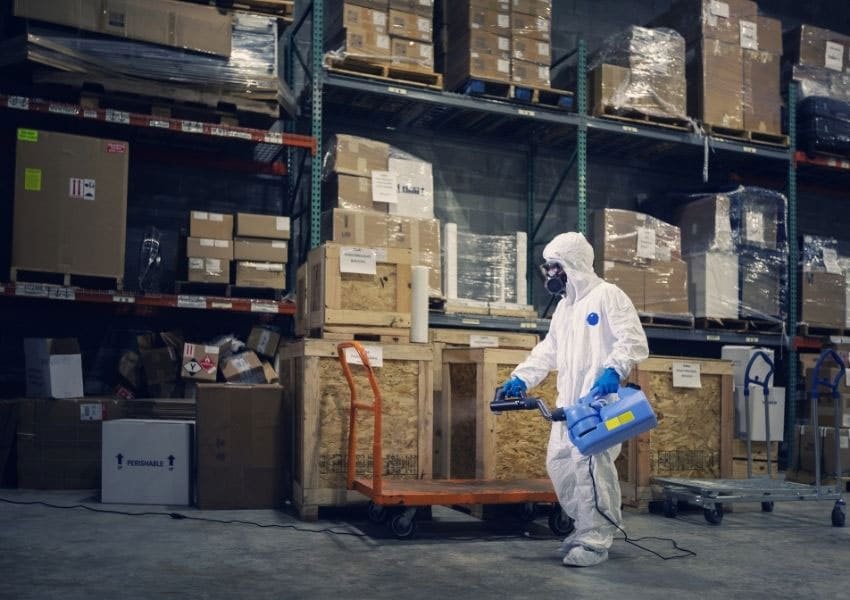
Creating a Warehouse Cleaning Plan
A well-structured cleaning plan is essential for maintaining cleanliness across all areas of the warehouse.
Assessing the Warehouse Layout: Begin by mapping out the warehouse layout. Identify high-traffic areas, zones with specific cleaning needs, and any hazardous materials that require special handling.
Setting Cleaning Priorities: Not all areas need the same level of attention. areas that have the most significant impact on operations and safety, such as loading docks, storage areas, and high-traffic pathways.
Establishing a Cleaning Schedule: Consistency is key. Develop a schedule that breaks down cleaning tasks into daily, weekly, and monthly intervals. Assign duties to guarantee that projects are finished on schedule and at the necessary quality.
Daily warehouse cleaning tasks
Daily cleaning tasks are essential to maintaining a baseline level of cleanliness and safety.
Sweeping and Dusting: Regular sweeping prevents dirt from accumulating on floors, reducing slip hazards. Dusting surfaces daily keeps shelves, equipment, and other areas free from dust buildup that can damage goods or machinery.
Waste Management: Empty recycling bins and garbage cans on a regular basis to keep waste from piling up. Proper waste management also reduces the risk of pests and odours.
Spot Cleaning: Address spills, stains, and other issues as they occur. Taking prompt action keeps small concerns from growing into bigger ones and contributes to keeping the surroundings tidy all day.

Weekly warehouse cleaning tasks
Weekly tasks involve more in-depth cleaning and maintenance:
Mopping Floors: Regular mopping removes grime and sticky residues that accumulate over time. Particular care should be paid to loading docks, busy areas, and any locations where spills frequently occur.
Cleaning Shelves and Storage Units: Dust and organise storage units to prevent clutter and ensure that inventory remains in good condition. Regular cleaning also reduces the risk of pests and contamination.
Checking for Pests: Conduct weekly inspections to identify any signs of pests, such as droppings, nests, or damage to goods. Early detection is key to preventing infestations and protecting your inventory.
Monthly Warehouse Cleaning Tasks
Dusting High Ceilings and Rafters: High ceilings, rafters, and beams can accumulate dust and cobwebs over time. These areas are often overlooked, but regular monthly cleaning helps prevent dust from falling onto products and equipment. To guarantee the security of your cleaning crew, PPE is essential. below, maintaining a cleaner overall environment.
Examining and Cleaning HVAC Systems: Keeping the warehouse’s air quality in check depends heavily on the HVAC system. Monthly inspections and cleaning of air ducts, filters, and vents are essential to prevent dust buildup and ensure efficient operation. Clean HVAC systems also reduce the risk of circulating dust and contaminants throughout the facility.
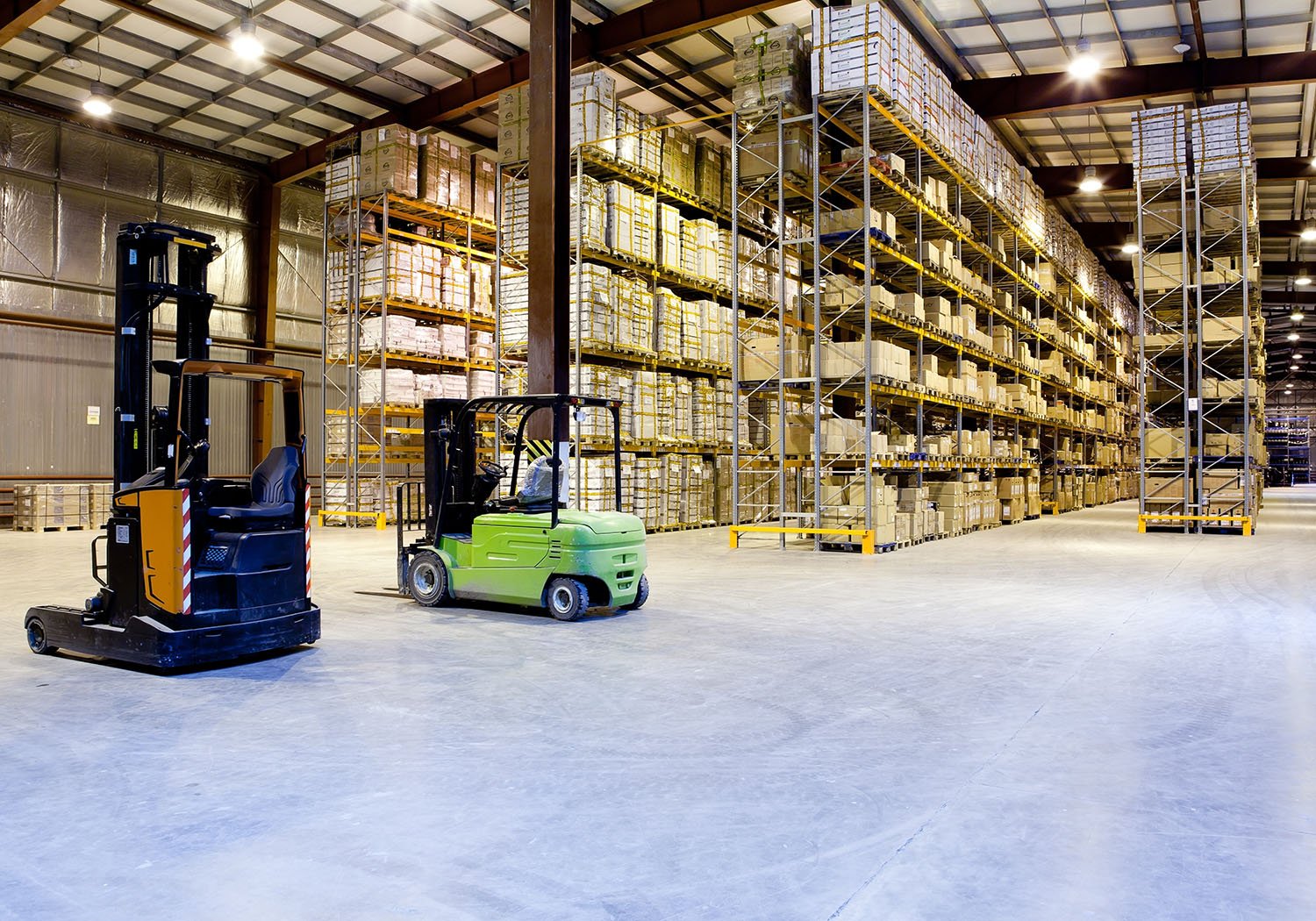
Specialised warehouse cleaning tasks
Some cleaning tasks are less frequent but are critical for maintaining a safe and productive warehouse environment.
Dealing with Spills and Contaminants: In warehouses handling chemicals, liquids, or hazardous materials, spills are a significant concern. Have spill kits readily available and ensure staff is trained in spill response protocols. Immediate and proper cleanup of spills is crucial to preventing accidents and contamination.
Cleaning Machinery and Equipment: Warehouse equipment, such as forklifts, conveyors, and pallet jacks, must be cleaned regularly to prevent dust and grime from affecting performance. Grease and oil buildup can be hazardous, so periodic deep cleaning of machinery is essential for both safety and operational efficiency.
Handling Hazardous Materials: If your warehouse stores hazardous materials, cleaning protocols must adhere to specific safety standards. This may include using specialised cleaning agents, proper disposal methods, and ensuring staff is trained to handle these materials safely. Maintaining clear, clean areas around hazardous materials also reduces the risk of accidents
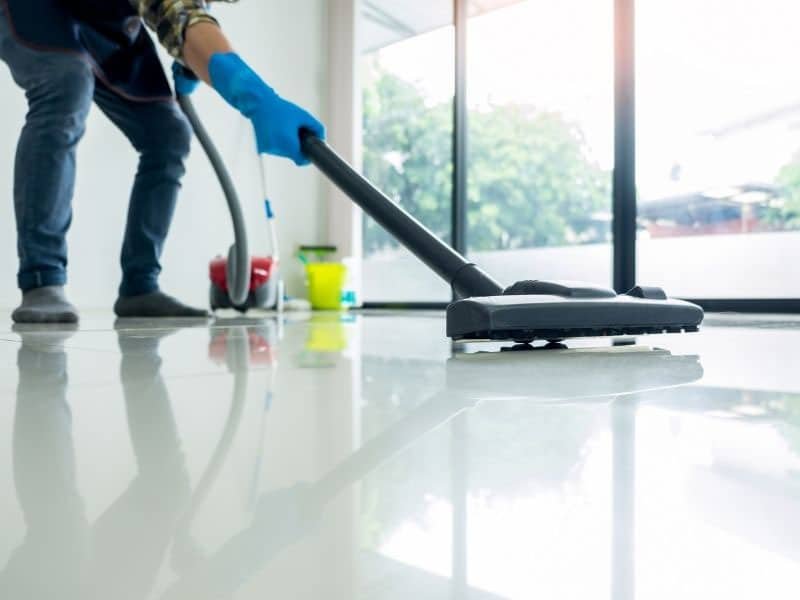
Essential warehouse cleaning tools and equipment
To tackle the diverse cleaning needs of a warehouse, it’s important to equip your cleaning team with the right tools and equipment:
Floor Sweepers and Scrubbers: Industrial floor sweepers and scrubbers are essential for maintaining clean floors, especially in large warehouses. These machines are designed to handle heavy-duty cleaning tasks quickly and efficiently.
Industrial Vacuums: High-powered vacuums are crucial for removing dust and debris from floors, shelves, and equipment. Some vacuums are specifically designed for hazardous dust, making them ideal for warehouses that handle fine particulate matter.
Cleaning Chemicals and Solutions: Depending on the materials stored in your warehouse, you may need a variety of cleaning chemicals, including degreasers, disinfectants, and eco-friendly solutions. Ensure that all chemicals are stored safely and that staff is trained in their proper use.
Personal Protective Equipment (PPE): Cleaning staff should always use appropriate PPE, including gloves, masks, goggles, and protective clothing, especially when handling hazardous materials or cleaning chemicals.

Sustainable and eco-friendly warehouse cleaning practices
As businesses increasingly focus on sustainability, adopting eco-friendly cleaning practices in your warehouse is not only responsible but also beneficial for your company’s image.
Using Green Cleaning Products: Choose environmentally friendly cleaning products that are free from harsh chemicals. Green products are safer for workers and reduce the environmental impact of your operations.
Reducing Water Waste: Implement water-saving practices such as using high-efficiency cleaning equipment and limiting the use of water to necessary tasks. Reusing water where possible, such as in industrial scrubbers, can also significantly reduce water consumption.
Recycling and Proper Waste Disposal: Set up a comprehensive recycling program for materials such as cardboard, plastic, and metal. Properly dispose of hazardous waste according to local regulations to minimise environmental impact and avoid potential fines.
Training warehouse staff on cleaning protocols
Effective cleaning starts with well-trained staff. Training needs to include both the methods and the significance of keeping a clean warehouse.
Importance of Training: Well-trained staff can identify cleaning needs, use equipment correctly, and handle hazardous materials safely. Proper training reduces the risk of accidents and ensures that cleaning tasks are performed consistently and effectively.
Key Cleaning Procedures: Staff should be trained in basic cleaning procedures, such as sweeping, mopping, waste disposal, and the use of cleaning equipment. They should also understand how to prioritise tasks based on the cleaning schedule.
Safety Protocols: Safety is paramount when cleaning a warehouse. Staff should be familiar with the use of PPE, the handling and storage of cleaning chemicals, and emergency procedures in case of spills or accidents.

Outsourcing warehouse cleaning services
While in-house cleaning is feasible for many tasks, outsourcing certain cleaning services can offer significant advantages:
Benefits of Hiring Professional Cleaners: Professional cleaning services bring expertise, specialised equipment, and the ability to handle challenging cleaning tasks that might be beyond the scope of in-house staff. They can also provide deep cleaning services on a regular basis, ensuring areas like high ceilings, HVAC systems, and machinery are thoroughly maintained.
How to Choose the Right Cleaning Service: When selecting a cleaning service, look for a company with experience in warehouse environments. Check references and reviews, ensure they have the necessary certifications for handling hazardous materials, and confirm that they can meet your specific cleaning needs and schedules.
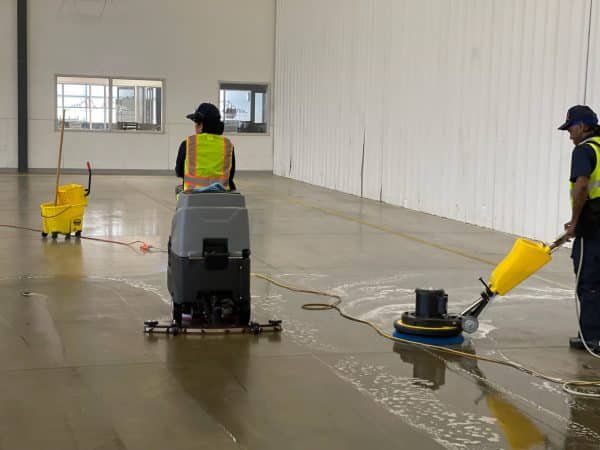
Maintaining a Clean Warehouse Over Time
Achieving a clean warehouse is just the beginning; maintaining it over time requires ongoing effort and vigilance.
Regular Inspections: Schedule regular inspections to assess cleanliness and identify any areas that need attention. Inspections should cover all areas of the warehouse, including storage zones, loading docks, and less frequently used spaces.
Addressing Issues Promptly: When cleanliness issues arise, address them immediately. Prompt action prevents small problems from escalating into larger ones that can impact operations or safety.
Continuous Improvement: Regularly review and update your cleaning plan based on feedback from staff and any changes in warehouse operations. Continuously improving your cleaning practices ensures that your warehouse remains a clean, safe, and efficient environment
Maintaining a clean warehouse is a multifaceted task that requires careful planning, the right tools, and a commitment to ongoing maintenance. A clean warehouse is not only about appearance; it’s essential for safety, efficiency, and protecting your valuable inventory. By developing a comprehensive cleaning strategy and consistently following through, you can create a workspace that supports productivity, minimises risks, and reflects positively on your company.
Investing in warehouse cleanliness pays off in the long run, from reducing accidents to extending the lifespan of equipment and improving overall operational efficiency. As the backbone of your supply chain, the warehouse deserves the attention and care that a thorough cleaning plan provides.


